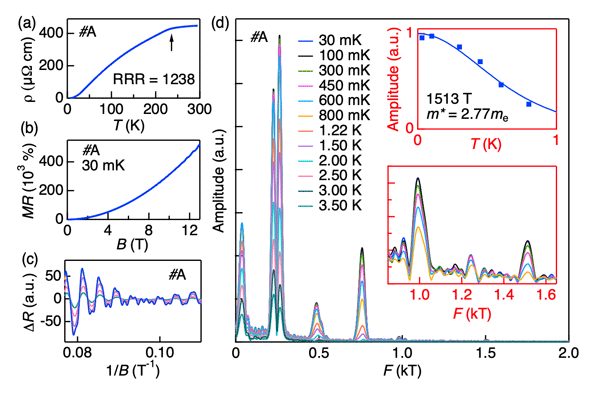PC1-5
Detection of hole pockets in the candidate type-II Weyl semimetal MoTe2 from Shubnikov-de Haas quantum oscillations
Dec.1 11:45-12:00 (Tokyo Time)
The Chinese University of Hong Kong, Hong Kong1
City University of Hong Kong, Hong Kong2
National High Magnetic Field Laboratory, Los Alamos National Laboratory, USA3
Tokyo Metropolitan University, Japan4
Kyoto University, Japan5
The bulk electronic structure of Td-MoTe2 features large hole Fermi pockets at the Brillouin zone center (Γ) and two electron Fermi surfaces along the Γ − X direction. However, the large hole pockets, whose existence has important implications for the Weyl physics of Td-MoTe2, had never been conclusively detected in quantum oscillations. This raises doubt on the realizability of Majorana states in Td-MoTe2, because these exotic states rely on the existence of Weyl points, which originated from the same band structure predicted by DFT. Here, we report an unambiguous detection of these elusive hole pockets via Shubnikov-de Haas (SdH) quantum oscillations. At ambient pressure, the quantum oscillation frequencies for these pockets are 988 T and 1513 T, when the magnetic field is applied along the c-axis. The quasiparticle effective masses m∗ associated with these frequencies are 1.50 me and 2.77 me, respectively, indicating the importance of Coulomb interactions in this system. We further measure the SdH oscillations under pressure. At 13 kbar, we detected a peak at 1798 T with m∗ = 2.86 me. Relative to the oscillation data at a lower pressure, the amplitude of this peak experienced an enhancement, which can be attributed to the reduced curvature of the hole pockets under pressure. Combining with DFT + U calculations, our data shed light on why these important hole pockets had not been detected until now.
Keywords: Weyl semimetal, Phase diagram, Quantum oscillation
